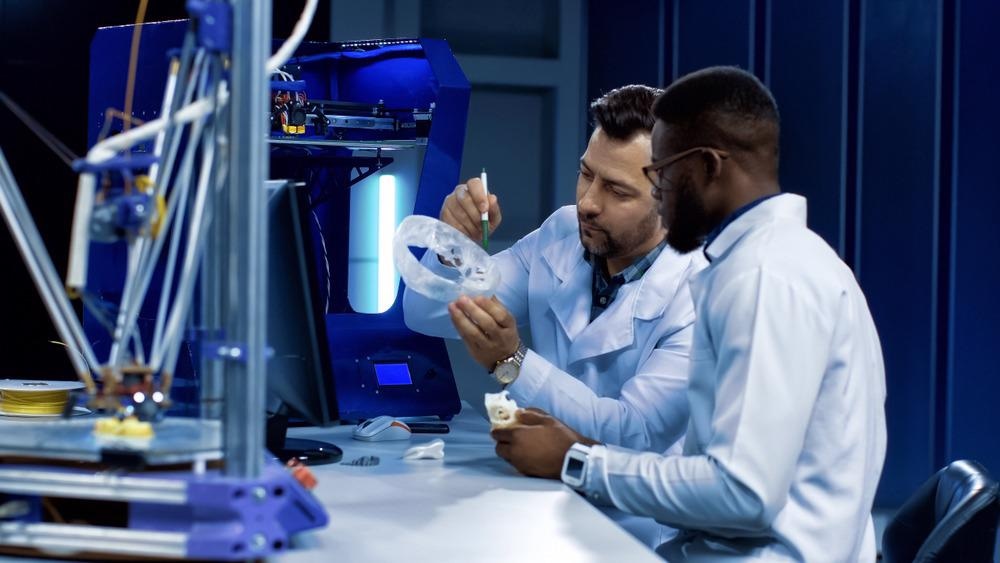 By Surbhi JainReviewed by Susha Cheriyedath, M.Sc.Feb 14 2022
By Surbhi JainReviewed by Susha Cheriyedath, M.Sc.Feb 14 2022In an article recently published in the journal Sensors and Actuators A: Physical, the researchers presented a 3D printed opto-microfluidic autonomous analyzer. They also reported a detailed analysis of its photometric applications.

Study: 3D printed opto-microfluidic autonomous analyzer for photometric applications. Image Credit: Frame Stock Footage/Shutterstock.com
Background
The growing interest in chemical parameter monitoring in environmental, medical, agricultural, and industrial processes necessitates the development of instrumental analytical systems. Microfluidics provides powerful platforms for automating and combining various and complicated fluid operations on a single chip.
Opto-microfluidics have a number of advantages, including portability, efficiency, sensitivity, adaptability, and low cost. Although several low-cost technologies have been reported for manufacturing microfluidic devices, they cannot be employed in automated analytical procedures such as micro total analysis systems or Lab-on-Chip devices.
Additive manufacturing technology is utilized as an alternative to traditional production, with fusion deposition modeling, commonly known as "3D printing," being one of the most common ways.
Modern analytical chemistry has recently joined the 3D printing revolution to develop and fabricate (bio) analytical chemistry systems. Low-cost photometric and fast prototyping devices have been made possible due to the development of 3D technology.
These advancements are mostly focused on flow detection cells, mixing systems, and electrochemical electrodes rather than the automation, mobility, or real-time analytical systems. Autonomous microfluidic systems for colorimetric measurements, on the other hand, are still in their infancy. There are sparse reports present in the literature on their environmental applications.
About the Study
In the present study, the authors reported an autonomous and miniaturized flow injection analytical procedure with auto-calibration controlled by a wireless connection which was implemented by building a novel 3D printed opto-microfluidic analyzer. To select the working wavelength in the visible range, the device included an RGB photodetection mechanism. This technique was first tested using solution dyes based on methyl red and methylene blue, and then with groundwater samples to determine the fluoride amounts.
The 3D-printed opto-microfluidic is made up of a photometric detection in the visible range and a mixing coil with five hydraulic ports that are connected to an auto-calibrated flow system. Wireless connectivity with XBee radio modules was used to control the system and generate real-time analytical data.
More from AZoM: Polyether Ether Ketone: Latest Developments and Applications
The communication lines could reach up to 100 meters in length. The measurement of solutions dyes based on methyl red and methylene blue was used to test the auto-calibration method. The quantification of fluoride amounts in groundwater samples was done by simplifying, miniaturizing, and automating the analytical technique.
Observations
The researchers observed a near-uniform linear trend (0.9923 for the methylene blue and 0.9972 for the methyl red). A straight-line relationship between methylene blue and methyl red, with sensitivities of 0.0674 and 0.0654 for methylene blue and 0.0485 and 0.0392 for methyl red, respectively, was observed. The proposed opto microfluidic device had a 79.65% reduction in waste generation, with the opto-microfluidic system generating 1.63 mL of waste compared to 8 mL for spectrophotometer readings.
The relative standard deviation estimated for a fluoride content of 1.5 mg L-1 was 0.07%. Furthermore, it was observed that the results obtained using the 3D printed opto-microfluidic analyzer were equivalent to those obtained using a commercially available device. The technology allowed for smaller instrumentation, fewer reagents, and lower energy consumption, resulting in considerable benefits for in situ and real-time analysis in a portable analytical system.
The microfluidic system's strong resilience to temperature and acidic solutions involved in various chemical processes was made possible by the polypropylene filament employed in its production. The technology demonstrated considerable advantages for an in situ and real-time portable analytical system by reducing apparatus size, reagents, and energy consumption.
Conclusions
In conclusion, this study elucidates the development of a 3D opto-microfluidic analyzer. Its self-contained microanalytical technique and proposed design enabled the definition of three operating wavelengths for evaluating water quality in environmental monitoring. The opto-microfluidic analyzer was used to test fluoride levels in groundwater samples, yielding accurate and traceable results.
Rapid prototyping, cheap cost, reduced size, and the creation of complicated microfluidic structures were all advantages of the opto-microfluidic analyzer created with the 3D printing technology. It was determined that a wireless sensor network with an application for the internet of things (IoT) to generate and process analytical data could be achieved with the addition of more nodes.
According to the study, several advantages of the proposed opto-microfluidic analyzer include portability, and in situ and real-time applications. The authors also believe that the opto-microfluidic system has the capability to be used in IoT to generate and analyze analytical data with the inclusion of additional nodes.
Disclaimer: The views expressed here are those of the author expressed in their private capacity and do not necessarily represent the views of AZoM.com Limited T/A AZoNetwork the owner and operator of this website. This disclaimer forms part of the Terms and conditions of use of this website.
Sources:
Camarillo, R. M., Flores, J. L., Garcia- Torales, G., et.al. 3D printed opto-microfluidic autonomous analyzer for photometric applications. Sensors and Actuators A: Physical 113425 (2022).
https://www.sciencedirect.com/science/article/abs/pii/S0924424722000632